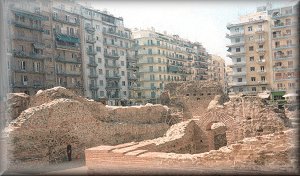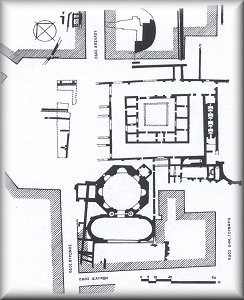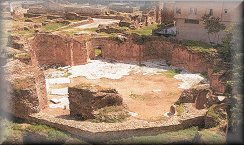
The Palace of Galerius
The group of buildings comprising the palace of Galeruis Maximianus was built around 305 AD and consists of the Palace, the Octagon, the Arch of Galerius, the Hippodrome and the Rotunda.
The Palace was an imposing structure on two floors, laid out around a large open courtyard (atrium) surrounded by a colonnade. Spacious corridors separated the rooms in the complex palace. There were apartments for the Emperor himself and chambers for his guard, for the courts and for other administrative operations. The rooms were ornamented with wall paintings, while the entire palace had mosaic floors showing compositions of plant and geometrical motifs. On the east side there was a two-storey arcade and springs and fountains have come to light at many points. The Palace was destroyed by an earthquake, probably in the eighth century. The pictures show the ruins of Galerius' Palace in Navarinu Sq. and the ground plan of Galerius' Palace


The Octagon, on the southwest side of the complex of buildings, is the best preserved of the palace structures. It is large, of an octagon shape, while around the interiour are semicircular recesses with a costly floor ornamented with marbletesselation.
 The Octagon was probably Galerius' throne room and it displays similarities to the mausoleum of the Roman Emperor Diocletian at Spoleto in Italy. Near the Octagon, archeologists discovered a large marble arch with ornamental reliefs on its fašade, including busts of Galerius, of Tyche - the goddess of good fortune - anf of Thessaloniki personified. This can now be seen in the Archeological Museum of Thessaloniki
The Octagon was probably Galerius' throne room and it displays similarities to the mausoleum of the Roman Emperor Diocletian at Spoleto in Italy. Near the Octagon, archeologists discovered a large marble arch with ornamental reliefs on its fašade, including busts of Galerius, of Tyche - the goddess of good fortune - anf of Thessaloniki personified. This can now be seen in the Archeological Museum of Thessaloniki
The hippodrome was the place where the citizens of Thessaloniki took their recreation. It occupies what is now Ippodromiou Square, and had an area of 30,000 square metres. However, the Hippodrome ceased to function abruptly in 390 AD, after the massacre in it of 7,000 cityfolk. The slaughter was ordered by the Emperor Theodosius himself, in anger when Botheric, the Goth, commander of the city garrison and friend of the Emperor was lynched by a frenzied mob for banning a popular charioteer from the horse races. After this bloody event, the Hippodrome was abandoned, fell into disuse and remained in the historical memory of the townspeople only as a place name, the "Podromi", which was in use down to the last years of Ottoman rule.